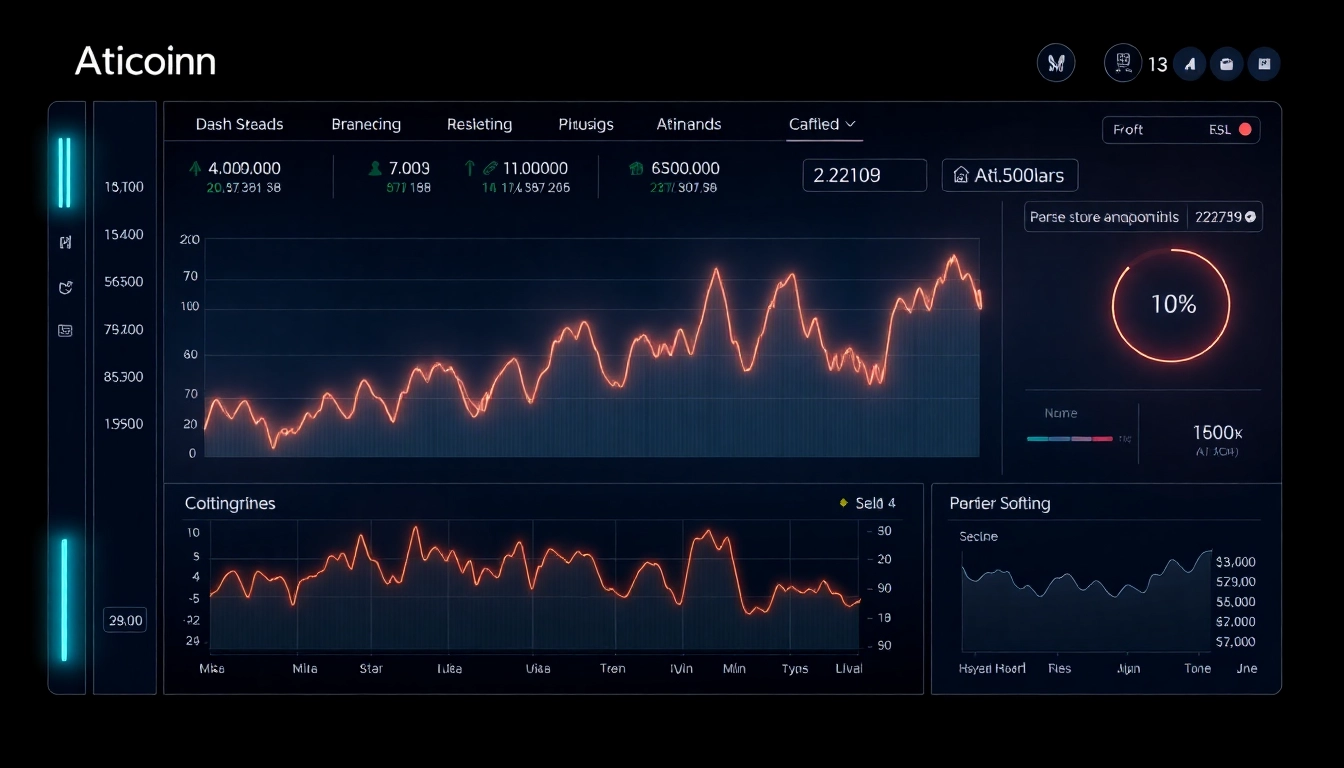Introduction to Crypto Mining: Fundamentals and Benefits
The landscape of digital currency has transformed the financial world, driven by innovative technology and decentralized networks. At the heart of this revolution lies crypto mining, a process that not only fuels the creation of new cryptocurrencies but also validates and secures transactions on blockchain networks. Understanding the fundamentals of crypto mining is essential for enthusiasts and investors aiming to navigate this complex yet lucrative domain. This comprehensive guide explores the core aspects of crypto mining, its benefits, common misconceptions, and strategies to maximize profitability.
What is crypto mining and how does it work?
Crypto mining is the mechanism by which transactions are verified, recorded, and added to a blockchain—an immutable digital ledger. This process involves solving complex mathematical problems, known as cryptographic puzzles, to validate new transactions and produce new coins as rewards. Miners utilize powerful hardware and software to perform these computations efficiently. For example, Bitcoin employs an algorithm called SHA-256, requiring specialized hardware known as ASICs, while Ethereum relies on GPU-based mining. The validation process not only maintains the integrity and security of the network but also incentivizes miners by awarding them newly minted coins—a process central to the issuance model of many cryptocurrencies.
The advantages of mining cryptocurrency in today’s market
Engaging in crypto mining offers numerous advantages, especially during the current market phase characterized by rising adoption and technological innovation. These benefits include:
- Passive income generation: Mining can create consistent revenue streams through coin rewards and transaction fees.
- Decentralization support: Miners help maintain the decentralization and resilience of blockchain networks.
- Asset accumulation: Mining provides an opportunity to acquire cryptocurrencies at lower costs, especially when market prices are favorable.
- Technical engagement: Miners develop expertise in blockchain technology, hardware, and software infrastructure.
Moreover, advances such as energy-efficient mining hardware and renewable energy integration are improving the sustainability and profitability of mining activities.
Common misconceptions about crypto mining profitability
Despite its potential, crypto mining is often misrepresented, leading to misconceptions such as:
- Mining is a guaranteed way to get rich: The reality is that profitability depends on several factors—hardware costs, electricity, market prices, and difficulty adjustments—making it a competitive and sometimes risky venture.
- Mining always remains profitable: Fluctuations in cryptocurrency prices and increases in mining difficulty can erode margins, especially for small-scale miners.
- Setup costs are minimal: High-quality mining hardware and infrastructure investments are significant, often running into thousands of dollars.
It is crucial for aspiring miners to perform thorough profitability analyses, considering all operational costs, to determine realistic returns.
Hardware and Software Essentials for Effective Crypto Mining
Selecting the right mining hardware: ASICs vs GPUs
Hardware selection is the foundation of a successful crypto mining operation. The primary options include Application-Specific Integrated Circuits (ASICs) and Graphics Processing Units (GPUs).
- ASICs: Custom-designed chips optimized for specific algorithms like SHA-256 used by Bitcoin. They offer superior hashing power and energy efficiency, making them ideal for large-scale, profit-driven mining farms. Examples include Bitmain’s Antminer series and MicroBT’s WhatsMiner.
- GPUs: General-purpose graphics cards suitable for various algorithms (e.g., Ethereum’s Ethash). They are more versatile and accessible for hobbyists and small-scale miners but less efficient than ASICs for high-volume mining.
When choosing hardware, consider factors such as initial investment, energy costs, expected hash rates, and the specific coin’s mining algorithm.
Top mining software options and setup guides
Effective mining requires robust software to connect hardware to the blockchain network, manage operations, and optimize performance. Popular software includes:
- CGMiner: Open-source, command-line-based, suitable for ASICs.
- NiceHash: User-friendly platform that allows buy/sell of hashing power across algorithms, ideal for beginners.
- Claymore Miner: Designed for Ethereum mining with features supporting dual mining.
Setting up mining software involves configuring wallet addresses, mining pools, and hardware parameters. Many providers offer step-by-step tutorials, emphasizing the importance of securing your private keys and employing reliable pool servers.
Optimizing your mining rig for maximum efficiency
To enhance profitability, miners should optimize their rigs through:
- Overclocking: Increasing hardware clock speeds while managing temperature thresholds.
- Undervolting: Reducing power consumption without sacrificing hash rate.
- Cooling solutions: Employing effective cooling to prevent overheating, such as liquid cooling or high-performance fans.
- Power management: Using energy-efficient power supplies and scheduling mining during off-peak hours to reduce electricity costs.
Regular maintenance and monitoring tools, like HWMonitor or MSI Afterburner, help keep hardware in peak condition, ensuring consistent output and lifespan extension.
Implementing Best Practices in Crypto Mining
Security measures to protect your mining operations
Security is a critical component of sustainable mining. Miners should implement:
- Secure wallets: Use hardware wallets or cold storage to safeguardcoin holdings.
- Network security: Employ firewalls, VPNs, and regular firmware updates to protect against hacking attempts.
- Operational security (OpSec): Keep hardware and mining pool details confidential to prevent targeted attacks.
- Monitoring tools: Utilize security analytics to detect unusual patterns or potential breaches.
Balancing security with operational efficiency ensures your investments are protected from theft and malicious attacks.
Energy consumption: Reduce costs and environmental impact
Energy consumption is a paramount concern, impacting both operational costs and environmental footprint. Strategies to mitigate include:
- Locating mining farms near renewable energy sources: Solar, hydro, or wind power significantly lowers electricity costs and reduces carbon footprint.
- Using energy-efficient hardware: ASIC miners tend to consume less power per unit of hashing power.
- Implementing energy management systems: Use smart grids and energy scheduling to minimize peak usage and costs.
Many jurisdictions are introducing regulations to curb excessive energy use, emphasizing sustainable practices in crypto mining.
Joining mining pools vs solo mining strategies
Miners often face the decision of joining pools versus mining independently:
- Mining pools: Combine resources with other miners to increase the chance of earning rewards, then split payouts proportionally. They provide steady income but involve pool fees and shared control.
- Solo mining: Mining independently offers full rewards but with higher variance and requires substantial processing power. Suitable for large operations with significant infrastructure.
The choice depends on your hardware capacity, risk appetite, and income stability preferences.
Performance Metrics and Profitability Analysis
Key indicators to track in crypto mining
Regular performance monitoring is essential to assess profitability and optimize operations. Important metrics include:
- Hash rate: The number of hashes computed per second, directly impacting potential rewards.
- Power consumption: Energy used per unit of hash rate, vital for cost calculations.
- Difficulty level: The measure of how hard it is to mine a block, adjusting periodically based on network activity.
- Reward per block: The amount of cryptocurrency awarded per mined block, which halves over time for Bitcoin.
- Pool payout rates: The average earnings from pool contributions.
Utilizing specialized dashboards and software, such as Mining Pool Stats or proprietary tools, allows real-time tracking and informed decision-making.
Calculating ROI and break-even points
To determine the viability of your mining setup, perform a comprehensive ROI analysis:
- Calculate initial hardware and setup costs.
- Estimate ongoing electricity and maintenance expenses.
- Factor in current coin market prices and rewards.
- Model expected daily or monthly income based on hash rates.
- Identify the break-even point—the time required to recover your initial investment.
Many tools and calculators, such as NiceHash’s profitability calculator, facilitate these assessments. Keep in mind that market volatility can significantly affect ROI timelines.
Adapting to market fluctuations and technological advances
The crypto mining industry remains dynamic, with evolving technology and market conditions. Proactive strategies include:
- Regularly updating hardware to leverage energy-efficient and higher-performance equipment.
- Monitoring cryptocurrency prices to optimize selling or hold strategies.
- Adjusting mining algorithms and pool choices in response to difficulty and profitability shifts.
- Staying informed about upcoming protocol changes or regulations that could impact mining activities.
Flexibility and continuous learning are critical to maintaining profitability and operational sustainability.
Future Trends and Legal Considerations in Crypto Mining
Emerging technologies and hardware innovations
The future of crypto mining is being shaped by cutting-edge advancements:
- Immersion cooling: Enhances hardware efficiency and lifespan, allowing higher overclocking potential.
- ASIC evolution: Next-generation chips offer higher performance with lower energy use.
- Quantum computing: Although still experimental, quantum tech could revolutionize cryptography and mining efficiency.
- Renewable energy integrations: Innovations in energy sourcing to create sustainable mining farms.
These developments promise increased efficiency, sustainability, and profitability for miners who adapt early.
Regulatory landscape and compliance tips
As governments worldwide develop regulations around cryptocurrencies, miners must stay compliant:
- Understand local laws regarding cryptocurrency taxation and reporting requirements.
- Ensure hardware import/export complies with national policies.
- Obtain necessary permits for large-scale operations.
- Implement AML (Anti-Money Laundering) and KYC (Know Your Customer) procedures where applicable.
- Engage with industry associations to stay informed of policy changes.
Proactive compliance not only reduces legal risks but also builds credibility within the industry.
Long-term sustainability and scaling your mining operations
Sustainability involves balancing profitability with environmental responsibility:
- Invest in renewable energy sources to reduce carbon footprint.
- Design scalable infrastructure to accommodate hardware upgrades and expansion.
- Adopt energy management and automation to optimize resource use.
- Explore diversification into staking or hybrid mining models.
Strategic planning ensures long-term growth, resilience against market volatility, and alignment with eco-friendly standards.







